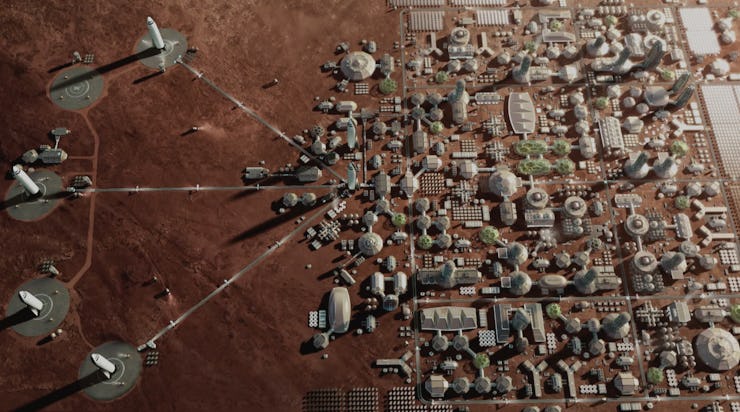A city on Mars could crop up in our lifetimes, but don’t expect them to resemble regular Earth dwellings. Lewis Dartnell, Ph.D., a research scientist with a position at the University of Westminster, claims that extraterrestrial dwellings could land on the red planet sooner rather than later, but the atmosphere and unique conditions would make everyday things like live TV and giant glass windows impossible.
“While the first human mission to land on Mars will likely take place in the next two decades, it will probably be more like 50-100 years before substantial numbers of people have moved to Mars to live in self-sustaining towns,” Dartnell tells Inverse.
Dartnell’s estimate is a touch more conservative than those from space-faring firms. SpaceX CEO Elon Musk is aiming for the first manned mission to Mars in around 2024, with the first base established in 2028. Boeing CEO Dennis Muilenburg claims his company will beat SpaceX to Mars, with a NASA joint collaboration set to start test flights next year.
Dartnell outlined his vision of the Mars home for interior design firm Hillarys, which looked at the unique considerations of the planet and how they would influence the final structure. The end result is below:
Dartnell's house of the future.
The image details several key aspects of the future design:
- Airlock front door. This consists of two sealable doors, separated by a short corridor, which together maintain the pressure and oxygen levels inside the house. It’s similar to a plane, but the airlock means visitors won’t have to depressurize the whole house. Note the thick walls, as Dartnell suggests burying the home under two to three meters of soil to protect against radiation.
- Spacesuit storage. These pressurized suits would replace the traditional coats.
- Gym. With Mars gravity just one-third the strength of Earth gravity, working out would help protect against muscle wasting away.
- Machinery room. This makes oxygen through electrolysis, splitting water into hydrogen and oxygen for breathing. It also recycles water, which humans would have to mine from ice reserves.
- Bathroom. This would filter and purify urine before returning it to the water supply. Other waste would be used to fertilize plants.
- Bedroom. This would be smaller due to the difficulty in creating large, pressurized spaces.
- Living room. Inhabitants would experience a 20-minute delay from transmissions from Mars to Earth, making live TV a non-starter. A more likely solution would be to download movies and store them on a home server. Without anything in the way of local amenities, dwellers would also have to cook at home every night and socialize with their housemates.
- Light shaft. This small skylight would keep inhabitants happy without letting in too much radiation.
- Greenhouse. This is likely the humans’ main source of food. Studies suggest that visitors could successfully grow tomatoes and other crops in Mars soil. Livestock is almost certainly out of the question, but humans could live on insects.
- Solar panels. While a simple source of energy, residents would need to regularly go outside and use a broom to push off collected dust after the storms.
These limitations may leave some to question why anyone would want to live on Mars. Paul Wooster, principal Mars development engineer for SpaceX, told an audience in September that these dwellings could support ambitious scientific research about life on Mars and the climate of the planet as well as serve as a site refuel rockets continuing on their journey to even more distant planets. With these soil-covered houses, humans could unlock some of the great secrets of the universe.
